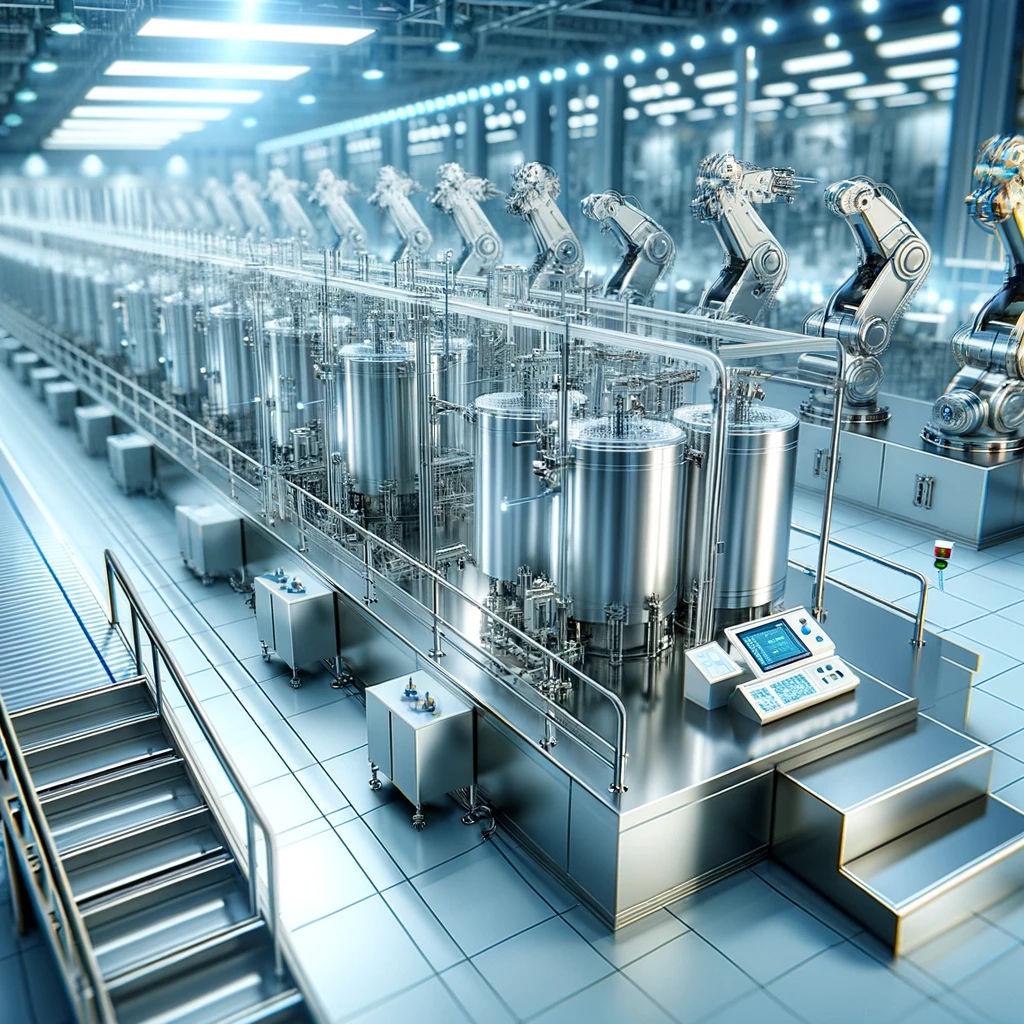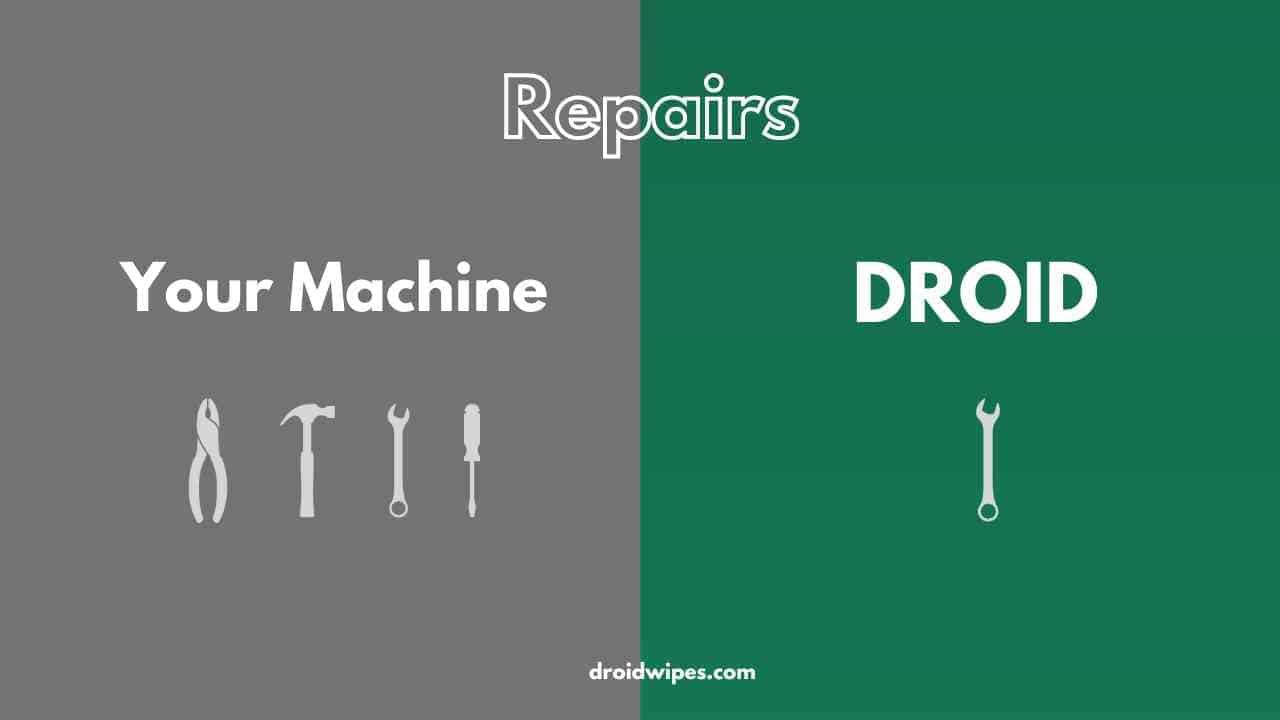1. Implement a Predictive Maintenance Program
Predictive maintenance is a proactive strategy that uses data and analytics to anticipate possible problems with your wet wipes machine before they develop into major concerns. This approach entails outfitting your wet wipes machine with diverse sensors that consistently monitor crucial factors such as temperature, vibration, and motor condition. The sensors gather live data, offering a full summary of the machine’s operating condition. By using advanced algorithms and machine learning models, it is possible to analyze this data and accurately forecast the potential failure of a component or the need for machine maintenance.
Predictive maintenance offers a key advantage by effectively reducing unexpected periods of inactivity. Conventional maintenance approaches, such as reactive maintenance, only deal with problems after they have already occurred, resulting in expensive disruptions in production. On the other hand, predictive maintenance enables the proactive arrangement of repairs and replacements of components within scheduled maintenance periods, so preventing unforeseen failures. This not only guarantees uninterrupted functioning but also enhances the maintenance schedule, making it more efficient and less disruptive to production.
Furthermore, the implementation of predictive maintenance plays a crucial role in enhancing the overall durability of your wet wipes machine by effectively mitigating excessive deterioration. Early identification and resolution of faults may reduce the likelihood of serious damage to components, hence extending their lifetime. This technique also facilitates more efficient resource allocation, since maintenance efforts are directed towards components that need care, rather than following a rigid timetable that might lead to wasteful labor. By incorporating predictive maintenance into your regular operations, you may improve the dependability and effectiveness of your wet wipes machine, thereby prolonging its operational lifespan and enhancing your financial performance.
2. Regularly Update Software and Firmware
It is essential to regularly update the software and firmware of your wet wipes machine to ensure it operates at its best and lasts for a long time. Updates offered by the wet wipes manufacturer for software and firmware often include crucial improvements, bug resolutions, and novel functionalities that may greatly increase the efficiency and functioning of the system. These upgrades may rectify identified vulnerabilities, therefore guaranteeing the safe and dependable operation of your equipment. Failure to implement these updates might leave your system vulnerable to malfunctions and cyber attacks, which may result in expensive periods of inactivity and repairs.
Regular software and firmware upgrades guarantee that your wet wipes machine stays compliant with the most recent technology and industry standards. With the advancement of technology, upgrades may provide enhancements in automation, data analytics, and integration capabilities, which may make your production processes more efficient. For example, an upgrade might improve the wet wipes machine’s capacity to interact with other equipment or software systems in your facility, so promoting improved coordination and efficiency. By keeping up-to-date with upgrades, you can fully capitalize on these improvements, guaranteeing that your wet wipes manufacturing line stays competitive and at the forefront of technology.
In addition, keeping your software and firmware up to date helps enhance the return on investment (ROI) of your wet wipes machine. These upgrades often prolong the operational lifespan of the equipment by enhancing its performance and offering additional functionalities that were not initially accessible when it was bought. This might result in a postponement of expensive upgrades or replacements, offering a cost-efficient method to maintain high manufacturing standards. In addition, frequent updates may aid in the detection and resolution of small problems before they develop into big difficulties, hence decreasing the likelihood of substantial delays to your production schedule. By consistently adhering to a schedule of software and firmware upgrades, you can guarantee optimal performance of your wet wipes machine, resulting in a steady and superior output throughout its lifecycle.
3. Use High-Quality Lubricants
Utilizing premium lubricants is crucial for ensuring the seamless and optimal functioning of your wet wipes machine. Lubricants reduce friction between mobile components, hence preventing the occurrence of mechanical malfunctions caused by wear and tear. Choosing high-quality lubricants that are suggested by the wet wipes manufacturer guarantees that the lubrication is precisely tailored to meet the unique requirements and tolerances of your machine’s components. High-quality lubricants often possess excellent thermal stability, allowing wet wipes manufacturers to retain their characteristics even when exposed to high temperatures. This attribute is particularly important for machines that work constantly or endure significant loads.
Effective lubrication is also a significant factor in enhancing the overall efficiency of your wet wipes machine. Premium lubricants reduce energy dissipation caused by friction, enabling the wet wipes machine to function more seamlessly and with less resistance. This may result in decreased energy usage and diminished operating expenses in the long run. In addition, components that are properly lubricated have reduced levels of stress and strain, leading to a longer lifetime and less need for replacements and repairs. By allocating resources to high-quality lubricants, you are making a strategic investment in the durability and dependability of your machinery.
It is equally crucial to have a consistent lubrication regimen. Even the most superior lubricants must be used at suitable intervals to provide uninterrupted protection and performance. Establish a maintenance regimen that includes periodic inspections and the refilling of lubricants according to the wet wipes manufacturer’s specifications. During these inspections, examine for indications of contamination or deterioration in the lubricant, since these factors might undermine its efficacy. By implementing a rigorous lubrication routine, not only will all moving components be appropriately protected, but it will also provide a chance to detect possible concerns at an early stage. Adopting this proactive maintenance strategy ensures that the equipment operates at its best and prevents the expensive consequences of unforeseen malfunctions and significant repairs.
Furthermore, it is crucial to educate your maintenance personnel about the importance of using the appropriate lubricant. Various elements of the wet wipes machine may need distinct lubricants, such as oils or greases with various viscosities and additives. utilizing an incorrect lubricant might result in harm to the equipment and nullify the advantages of utilizing top-notch items. Providing your staff with training to identify and use suitable lubricants guarantees optimal maintenance for every component of the machine, resulting in a more dependable and long-lasting production line. To optimize the efficiency and longevity of your wet wipes machine, it is crucial to prioritize the use of top-notch lubricants and adhere to a regular lubrication timetable.
4. Train Your Operators
Effectively educating your workers is a crucial element in prolonging the longevity of your wet wipes machine. Operators who possess expertise and a deep understanding are less prone to committing mistakes that might result in equipment damage or hinder the efficiency of the manufacturing process. Thorough training programs should include all facets of machine operation, including methods for starting up and shutting down, regular maintenance activities, resolving frequent problems, and comprehending the machine’s control systems and software. To minimize the risk of operational accidents that may lead to expensive repairs or downtime, it is crucial to ensure that operators possess extensive knowledge in these domains.
Training should also stress the significance of following the wet wipes manufacturer’s instructions and recommended procedures for operating and maintaining the equipment. This entails comprehending the precise specifications for lubrication, cleaning, and component substitutions, as well as identifying the first indications of deterioration or prospective issues. Proficient operators can promptly recognize and resolve small problems before they develop into significant breakdowns, guaranteeing that the equipment maintains its best operational state.
Furthermore, it is crucial to attend frequent refresher courses and stay updated on new technology or procedural changes. Staying abreast of the ever-changing production environment and technology is crucial to guarantee that your staff remains skilled and self-assured in their respective jobs. Continuing education promotes a culture of constant improvement and attentiveness, encouraging operators to be proactive in preserving the wet wipes machine’s well-being. By allocating resources to the appropriate training of your operators, you not only improve the effectiveness and security of your production line but also make a substantial contribution to the durability and dependability of your wet wipes machine.
5. Schedule Regular Inspections
Implementing frequent inspections is an essential procedure to guarantee the durability and dependability of your wet wipes machine. These inspections provide qualified experts the chance to meticulously scrutinize the equipment and detect any indications of deterioration, possible problems, or components that may need replacement. By doing regular inspections, you may detect small issues at an early stage, so avoiding them from developing into significant breakdowns that may need expensive repairs and cause prolonged periods of inactivity. A well-managed inspection plan serves as a proactive step, aiding in the preservation of the machine’s peak performance and prolonging its operating lifespan.
Thorough inspections should include all essential elements of the wet wipes machine. This involves inspecting the state of the components that are responsible for movement, such as moving parts, belts, bearings, and motors, as well as evaluating the levels and quality of lubrication. Technicians should further examine electrical connections, control systems, and software functionality to verify that all components are functioning as intended. Every inspection should adhere to a comprehensive checklist customized to your particular machine type, guaranteeing that no component of the machine is neglected. Recording the outcomes of every inspection is crucial for monitoring the machine’s state over time and making well-informed choices for maintenance and component replacements.
Furthermore, including inspections into a methodical maintenance schedule guarantees uniformity and dependability. Create a timetable that includes regular monthly, quarterly, and yearly examinations, each with its specific duties and areas of emphasis. Monthly inspections are capable of doing fundamental tests and maintenance chores, whilst more comprehensive quarterly and yearly inspections may dive more extensively into the machine’s state. This hierarchical technique enables consistent monitoring of both small and important elements of machine well-being, guaranteeing its optimal state throughout its lifespan.
Regular inspections not only help avoid problems but also enhance safety and ensure compliance. Insufficient maintenance of wet wipes machines may provide safety hazards to operators and other individuals. Wet wipes machines that undergo regular inspections are less prone to experiencing dangerous breakdowns, thereby guaranteeing a safer working environment. Moreover, following a rigorous inspection timetable may assist you in conforming to industry rules and standards, so preventing any penalties or legal complications associated with equipment safety and performance.
In general, committing to frequent inspections is a proactive approach that not only improves the lifetime of your wet wipes machine but also maximizes its efficiency, safety, and dependability. By promptly identifying problems and adhering to a regular inspection schedule, you can guarantee uninterrupted, top-notch manufacturing and safeguard your investment in this crucial equipment.
6. Keep the Machine Clean
Ensuring the hygiene of your wet wipes machine is crucial for achieving its maximum performance and durability. Accumulated dirt, dust, and debris may impede the functionality of the machine’s moving components, sensors, and control systems, resulting in inefficiencies and even malfunctions. By implementing a meticulous cleaning program, one may effectively avoid these problems, thereby guaranteeing the wet wipes machine’s smooth and dependable operation. Regular maintenance not only improves the wet wipes machine’s performance but also increases the cleanliness and quality of the wet wipes produced.
An immaculate apparatus is less susceptible to mechanical malfunctions resulting from impurities. Particles of dust and debris may generate friction and abrasion on components in motion, resulting in early degradation. Regularly eliminating these impurities decreases the likelihood of avoidable damage, hence prolonging the lifespan of the wet wipes machine’s parts. In addition, a pristine atmosphere is essential for preserving the precision and dependability of sensors and control systems, which play a vital role in the accurate functioning of contemporary wet wipes machines. Regular maintenance of sensors ensures precise monitoring of the wet wipes machine’s functioning, leading to constant product quality and operating efficiency.
Furthermore, preserving cleanliness is crucial for guaranteeing product excellence and adherence to health and safety regulations. Wet wipes are used for personal care and hygiene purposes, hence they must be manufactured in a sterile setting. The presence of any impurities originating from the machine might undermine the excellence and security of the wipes, resulting in possible health hazards for customers and legal responsibilities for your firm. Maintaining the cleanliness of the machine ensures adherence to stringent product integrity standards, fulfilling regulatory mandates, and achieving consumer expectations.
Developing a comprehensive cleaning strategy is crucial for ensuring efficient upkeep. The procedure should delineate the precise cleaning jobs, their respective frequencies, and the suitable cleaning products and instruments to be used. For example, regular cleaning may include the act of wiping surfaces and eliminating apparent dirt, but periodic deep cleaning may involve the process of dismantling components for a comprehensive cleaning and examination. Additionally, it is crucial to use cleaning products that are suitable for the wet wipes machine’s components to prevent any potential chemical harm. Providing training to your maintenance team about appropriate cleaning procedures and the significance of cleanliness guarantees uniformity and meticulousness in the cleaning procedure.
Integrating cleanliness into the comprehensive maintenance approach also promotes a more secure working environment. Regularly cleaning machines reduces the likelihood of oil, grease, or other hazardous chemicals collecting in locations that might potentially cause slip-and-fall accidents or other safety dangers for workers. Maintaining a tidy work environment promotes safety and encourages a mindset of caution and attentiveness among your employees.
Ultimately, maintaining the cleanliness of your wet wipes machine is an essential activity that improves its functionality, prolongs its longevity, and guarantees the excellence and safety of the items you produce. To safeguard your investment and ensure effective, dependable, and secure manufacturing operations, it is crucial to establish and adhere to a thorough cleaning strategy and regular cleaning timetable.
7. Monitor Environmental Conditions
Ensuring the best performance and lifetime of your wet wipes machine is essential by closely monitoring the environmental parameters of your manufacturing facility. Temperature, humidity, and air quality are influential factors that may have a considerable influence on both the functioning of the machine and the quality of the created items. Maintaining a production environment that continuously adheres to the prescribed specifications is crucial for preventing possible problems that may result in equipment deterioration, malfunctions, or product defects.
Effective temperature regulation is of utmost significance. Elevated temperatures may result in the expansion of elements inside the wet wipes machine, which in turn can lead to heightened levels of friction and wear on the machine’s moving components. Over some time, this might lead to early malfunction of parts and decreased operational effectiveness of the machine. On the other hand, if the wet wipes machine is used in a very cold setting, it might make some materials more prone to breaking because they become brittle. Ensuring a consistent and reasonable temperature in the production area is crucial for maintaining the machine’s optimal functioning and preventing any damage or performance issues, thereby extending its lifetime and guaranteeing dependable operation.
The health of your wet wipes machine is also significantly influenced by humidity levels. Elevated humidity levels may result in the formation of condensation on the various parts of the machine, which can subsequently lead to corrosion and electrical malfunctions. This is a particular challenge for delicate electrical components and sensors since they are prone to malfunctioning when exposed to dampness. Conversely, too low humidity may lead to the accumulation of static electricity, which may disrupt the electrical systems of the machine and perhaps harm fragile components. Employing dehumidifiers or humidifiers in the production area to regulate humidity levels safeguards the machine from detrimental consequences, guaranteeing uninterrupted functioning and minimizing the likelihood of unforeseen periods of inactivity.
Another crucial aspect to take into account is the quality of the air. The accumulation of dust and airborne particles on the machine’s components may result in blockages, heightened friction, and increased wear. Furthermore, these impurities have the potential to disrupt the sensors and control systems of the wet wipes machine, leading to errors and failures. Installing air filtration systems in the production area may greatly decrease the presence of dust and particle matter in the air, safeguarding the machine and improving its operational dependability. Consistently replacing filters and upkeeping the air filtration system guarantees optimal performance, creating a hygienic and secure setting for both the equipment and the personnel.
In addition, the monitoring of environmental conditions facilitates adherence to industry norms and laws. Various regulatory agencies impose precise criteria on the environmental circumstances in which certain items must be produced. Ensuring that your manufacturing facility adheres to these standards helps prevent any compliance concerns and guarantees the constant high quality of your goods.
Integrating environmental monitoring into your comprehensive maintenance approach entails using sensors and monitoring systems to consistently monitor temperature, humidity, and air quality. These systems can promptly notify users if circumstances depart from the permissible range, enabling urgent remedial measures to be taken. In addition, conducting frequent audits and maintenance of the environmental control systems is crucial to maintaining their proper working and the provision of accurate data.
Ultimately, it is crucial to monitor and maintain ideal environmental conditions in your manufacturing facility to ensure the durability and efficiency of your wet wipes machine. By regulating temperature, humidity, and air quality, you can safeguard the machine from detrimental impacts, maintain uniform product quality, and adhere to industry rules. Implementing this proactive strategy fosters a stable, streamlined, and secure production setting, so enhancing the overall prosperity and durability of your manufacturing activities.
8. Replace Worn-Out Parts Promptly
Timely replacement of worn components is a crucial practice for ensuring the effectiveness and durability of your wet wipes machine. All wet wipes machines, irrespective of their caliber, undergo degradation and deterioration as time passes. Components that undergo prolonged use will gradually deteriorate, resulting in reduced performance and a heightened likelihood of malfunction. By identifying and replacing these components before their failure, one may effectively avoid small complications from growing into significant concerns, thus guaranteeing the smooth and dependable operation of the wet wipes machine.
Timely replacement of parts is advantageous as it helps to avoid unforeseen periods of inactivity. The presence of a solitary deteriorated element might lead to substantial interruptions in your wet wipes manufacturing process, leading to expensive setbacks and a decrease in income. To ensure uninterrupted output and adhere to consistent schedules, it is crucial to conduct frequent inspections of your machine and promptly replace any worn-out components. Adopting this preventative strategy not only saves time but also decreases the overall expenses linked to sudden repairs and interruptions in production.
Timely replacement of worn-out components not only prevents downtime but also improves the overall efficiency of your wet wipes machine. Well-maintained components enhance the efficiency of the machine, enabling it to function at its highest level of speed and precision. However, worn components may lead to misalignments, heightened friction, and other problems that undermine the overall quality of the end product. To maintain high manufacturing standards and constantly offer top-quality wet wipes to clients, it is essential to ensure that all components are in optimal condition.
Moreover, it is essential to use authentic, manufacturer-endorsed components to ensure the durability and efficiency of your device. Although it may be tempting to choose less expensive, non-genuine components to save costs, these alternatives sometimes exhibit worse quality and may not align or operate properly inside the device. Employing the appropriate components guarantees compatibility and dependability, hence reducing the likelihood of further harm or malfunction. Furthermore, it ensures the preservation of any warranties or service agreements you own with the manufacturer, so offering further safeguarding for your investment.
Implementing a methodical strategy for component replacement entails keeping a stock of crucial spare parts and arranging periodic maintenance inspections. Maintain a record of the use and state of crucial components, and replace them based on the intervals specified by the wet wipes machine manufacturer or earlier if signs of deterioration are apparent. The availability of spare parts reduces replacement time and enables prompt restoration of full wet wipes machine functionality.
Furthermore, it is crucial to provide training to your maintenance personnel to enable them to identify the first indications of deterioration and comprehend the need for prompt replacements. Providing your staff with knowledge about the precise wear patterns and breakdown locations of your wet wipes machine empowers them to promptly and effectively. This understanding guarantees that the replacement of parts is done with efficiency and effectiveness, so contributing to the general well-being of the wet wipes machine.
To summarize, timely replacement of worn-out components is a crucial feature of preserving functionality and prolonging the longevity of your wet wipes machine. This proactive maintenance method mitigates the occurrence of unforeseen periods of inactivity, improves the effectiveness of the machine, and guarantees the creation of goods of superior quality. By using authentic components and employing a methodical strategy for part substitution, you may safeguard your financial commitment and enhance the sustained prosperity of your manufacturing endeavors.
9. Calibrate Regularly
Regular calibration of your wet wipes machine is crucial for guaranteeing its precision and accuracy in production. Calibration is the fine-tuning of the wet wipes machine’s settings and components to ensure that it remains in line with predetermined standards and tolerances. Over time, the wet wipes machine’s performance may deviate from its initial settings as a result of variables such as deterioration, changes in the environment, and uninterrupted use. Regular calibration rectifies these discrepancies, guaranteeing that the wet wipes machine maintains maximum performance and produces wet wipes of superior quality.
Regular calibration has a key advantage in preserving the quality of products. Minor adjustments in wet wipes machine settings throughout the wet wipes production process might result in differences in the dimensions, density, moisture level, and packing of the wipes. These disparities might lead to faulty merchandise, resulting in heightened wastage and consumer discontent. Regularly calibrating the equipment guarantees that it conforms to the exact parameters necessary for maintaining constant product quality, therefore satisfying customer expectations and regulatory norms.
Calibration is essential for maximizing the machine’s performance and efficiency. A properly calibrated wet wipes machine functions with more efficiency, hence decreasing the stress on its parts and lessening the likelihood of mechanical malfunctions. Not only does this increase the machine’s longevity, but it also improves its general efficiency. For example, accurate calibration may enhance the coordination of different components, resulting in accelerated production cycles and reduced downtime. Regular calibration enhances the wet wipes machine’s production and profitability.
Furthermore, consistent calibration aids in the early detection of possible errors before they escalate into significant difficulties. Technicians can identify indications of wear, misalignment, or other problems that might impact the machine’s functionality during the calibration procedure. By addressing these difficulties at an early stage, it is possible to avoid expensive repairs and unforeseen failures, therefore guaranteeing continued output. Implementing this preventive maintenance strategy not only results in time and cost savings but also improves the dependability of your wet wipes manufacturing line.
To establish a successful calibration program, it is crucial to adhere to the rules and suggestions provided by the wet wipes machine manufacturer. These instructions provide precise time intervals for calibration, taking into account the wet wipes machine’s use and operational circumstances. Aside from regular calibrations, it is advisable to do extra inspections anytime there are notable changes in production volume, product specifications, or environmental circumstances. This guarantees that the equipment maintains its calibration according to the present operating demands.
It is essential to invest in appropriate calibrating equipment and provide training for your maintenance team. Technicians must possess the requisite equipment and expertise to carry out precise calibrations. Consistent training and periodic updates on calibrating procedures and best practices guarantee that your staff maintains a high level of skill and stays current with the newest innovations. Their knowledge enables them to conduct calibrations with efficiency and effectiveness, ensuring the machine’s ideal performance is maintained.
Regular calibration is essential for ensuring the accuracy, effectiveness, and durability of your wet wipes machine. By adhering to predetermined standards, you may achieve consistent production of high-quality goods, maximize performance, and proactively mitigate future difficulties. To attain these objectives and ensure the long-term profitability and dependability of your manufacturing processes, it is important to implement a systematic calibration program, adhere to manufacturer recommendations, and invest in appropriate training and equipment.
10. Foster a Culture of Continuous Improvement
Establishing a culture that consistently strives for improvement within your company is essential for boosting the efficiency and durability of your wet wipes machine. Continuous improvement is the ongoing evaluation and optimization of procedures, methodologies, and technology to attain gradual enhancements in efficiency, quality, and production. By incorporating this approach into your company’s core values, you promote proactive problem-solving and creativity, resulting in substantial long-term advantages for your wet wipes manufacturing processes.
Leadership is the foundation of a culture that emphasizes ongoing progress. Company leaders and management must exhibit a dedication to continuous improvement by establishing explicit objectives, allocating essential resources, and acknowledging the contributions of individuals who contribute to enhancing processes. The commitment should be effectively conveyed across all hierarchical levels of the business, fostering a cohesive and shared vision of exceptional performance. When workers see that the leadership places high importance on continuous improvement, they are more inclined to actively participate in and endorse projects that aim to enhance the performance of the wet wipes machine and other equipment.
Promoting employee engagement is a crucial element of ongoing improvement. The wet wipes machine operators and maintenance personnel, who interact with the machine regularly, are often the first individuals to identify inefficiencies or possible problems. By cultivating a conducive atmosphere whereby workers feel at ease to express their views and comments, you may access a rich reservoir of insights and ideas. Incorporate periodic feedback sessions, suggestion boxes, and team meetings as mechanisms to collect input from your workers. Providing recognition and rewards for contributions to improvement projects enhances employee motivation to actively engage in the process.
By adopting a systematic approach to continuous improvement, such as using Lean Manufacturing or Six Sigma approaches, organizations may establish an organized framework for recognizing, examining, and resolving inefficiencies. These approaches provide a range of tools and strategies that may be used to solve problems systematically and optimize processes. Lean methodology prioritizes the elimination of waste and the maximization of value, while Six Sigma methodology emphasizes minimizing variability and enhancing quality. Providing staff with training in these approaches enables them to successfully participate in ongoing improvement initiatives.
Consistently examining and evaluating performance data is crucial for identifying areas that need improvement. Utilize key performance indicators (KPIs) and metrics to oversee the effectiveness, excellence, and dependability of your wet wipes machine. Examining this data facilitates the identification of patterns, irregularities, and possible concerns that may need action. Deploying real-time monitoring systems enables prompt access to information, facilitating rapid adaptations and ongoing optimization of processes. Data-driven decision-making guarantees that improvement efforts are grounded in empirical data, resulting in more efficient and enduring results.
Another crucial element of continuous improvement is allocating resources towards continual training and development for your workforce. Regular training sessions ensure that personnel are kept up-to-date on the most current best practices, technology, and industry standards. Training personnel to fulfill several jobs may improve operational flexibility and resilience. By placing education and development as a top priority, you enable your staff to effectively adjust to changes and consistently pursue chances for improvement.
Integrating innovation into your ongoing attempts to improve may result in substantial progress. Keep yourself updated on developing technology and industry trends that have the potential to enhance your manufacturing operations. Advancements in automation, data analytics, and machine learning may provide innovative methods to enhance the efficiency and upkeep of your wet wipes machine. Embracing experimentation and pilot projects enables you to evaluate novel concepts and solutions, cultivating a culture of innovation and advancement.
Ultimately, cultivating a culture that prioritizes ongoing improvement is crucial for optimizing the efficiency and longevity of your wet wipes machine. By actively involving people, adopting well-defined procedures, using data, and making investments in training and innovation, you establish a work environment where continuous improvement becomes the standard. By adopting this proactive strategy, you can ensure that your wet wipes manufacturing processes maintain maintained efficiency, quality, and dependability. This, in turn, will support the long-term success and competitiveness of your organization.











